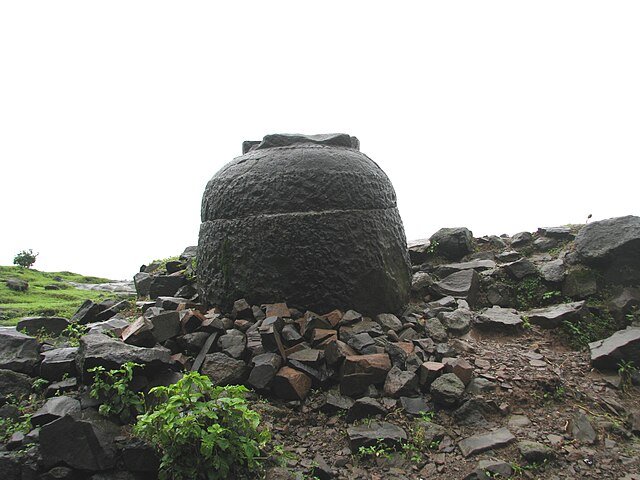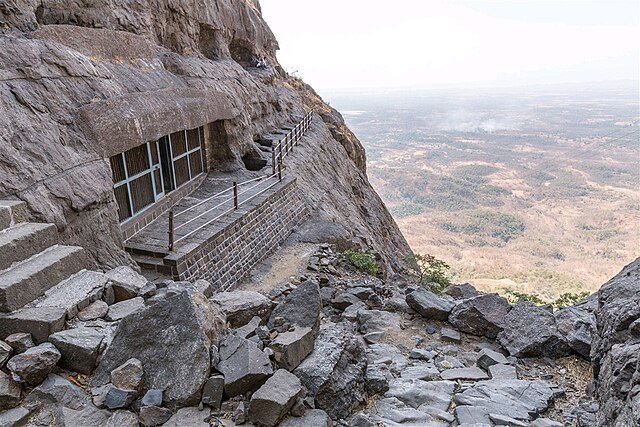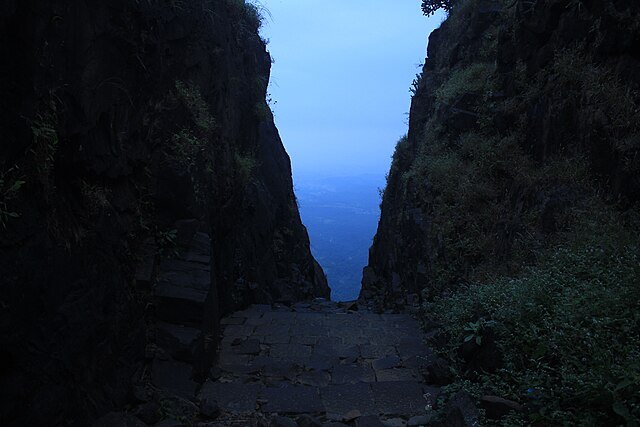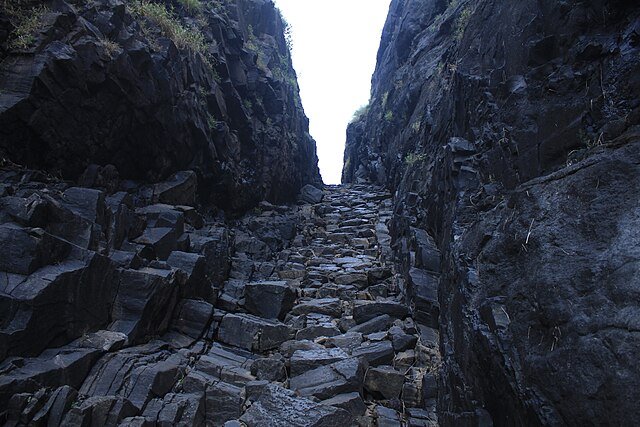Naneghat: Best of History, Trekking Guide, & Complete Travel Experience
- Location: Pune
- Entry Fee: Free
- Timings: Full Day
- Categories: Historical Place, Mountains, Hills, Tourist Places
- Tags: Best treks near Mumbai and Pune, Naneghat, Naneghat caves, Naneghat history, Naneghat trek, Reverse waterfall Naneghat, Satavahana History
- Location Taxonomy: India, Maharashtra, Pune
Maharashtra’s Sahyadri ranges are filled with ancient passes, forts, and caves that narrate stories of trade, culture, and spirituality. Among them, Naneghat is one of the most fascinating destinations. Known as an ancient trade route during the Satavahana dynasty, Naneghat is today a popular trekking spot near Mumbai and Pune.
The word Naneghat literally translates to “Coin Pass.” Traders traveling between the Konkan coast and the Deccan plateau once paid tolls here in the form of coins, giving the pass its unique name. With its rock‑cut caves, inscriptions, waterfalls, and panoramic views, Naneghat is a blend of history, adventure, and natural beauty.
This article explores the history, trekking routes, attractions, nearby places, and FAQs about Naneghat, making it a complete guide for travelers.
Historical Background of Naneghat

- Satavahana Dynasty: Naneghat was a vital trade route during the Satavahana period (200 BCE – 200 CE).
- Trade Importance: It connected the Konkan ports with Junnar, which was a flourishing marketplace.
- Toll Collection: Traders paid tolls in coins at the pass, hence the name Naneghat.
- Inscriptions: Brahmi inscriptions found in the caves provide insights into Satavahana rulers and their donations.
- Caves and Sculptures: Rock‑cut caves were used as rest houses for traders and contain carvings of deities.
Architectural and Natural Features

The ghat is not just a trekking trail but also an archaeological site.
Key Highlights:
- Rock‑Cut Caves: Ancient caves with inscriptions in Brahmi script.
- Stone Jar (Ranjan): A massive stone vessel once used for collecting tolls.
- Inscriptions: Records of Satavahana rulers and donations to Buddhist and Hindu deities.
- Reverse Waterfall: A unique phenomenon during monsoon where strong winds push water upwards.
- Panoramic Views: Stunning vistas of Malshej Ghat, Junnar, and surrounding valleys.
Trekking Experience at Naneghat

Trekking to The ghat is one of the most popular weekend adventures near Mumbai and Pune.
Trekking Route:
- Base Village: Vaishakhare, near Malshej Ghat.
- Altitude: 2,600 feet (792 meters).
- Distance: Approx. 5 km one way.
- Duration: 3–4 hours to ascend, 2–3 hours to descend.
- Difficulty Level: Easy to moderate, suitable for beginners.
Highlights of the Trek:
- Forest Trail: Lush greenery and streams during monsoon.
- Rock‑Cut Steps: Ancient steps carved into the mountain.
- Caves and Inscriptions: Historical remains of Satavahana period.
- Reverse Waterfall: A monsoon spectacle.
- Summit Views: Panoramic views of Sahyadris and Konkan plateau.
Flora and Fauna

- Flora: Wildflowers, medicinal herbs, and dense forests.
- Fauna: Monkeys, peacocks, and bird species.
- Birdwatching: Paradise for bird lovers, especially during monsoon.
Location and Accessibility
- District: Pune, Maharashtra
- Altitude: 2,600 feet (792 meters)
- Nearest Towns: Junnar (30 km), Malshej Ghat (20 km)
- Nearest Railway Station: Kalyan (120 km)
- Nearest Airport: Pune Airport (120 km), Mumbai Airport (150 km)
How to Reach:
- From Mumbai: 150 km (approx. 4–5 hours by road).
- From Pune: 120 km (approx. 3–4 hours by road).
- From Nashik: 160 km (approx. 4 hours by road).
Best Time to Visit Naneghat

- Monsoon (July–September): Waterfalls, greenery, and reverse waterfall.
- Winter (October–February): Pleasant weather, ideal for trekking.
- Summer (March–June): Hot and dry, less recommended.
Entry Fees and Timings
- Entry Fee: Free (no charges for trekking).
- Timings: Open all year round; best to trek between sunrise and sunset.
- Guides: Local guides available at Vaishakhare village.
Things to See at Naneghat
- Rock‑Cut Caves – Ancient caves with inscriptions.
- Stone Jar (Ranjan) – Used for collecting tolls.
- Brahmi Inscriptions – Historical records of Satavahana rulers.
- Reverse Waterfall – Unique monsoon attraction.
- Panoramic Views – Sahyadri ranges and Konkan plateau.
- Wildflower Meadows – Blooming landscapes during monsoon.
Nearest Tourist Places
- Junnar (30 km): Famous for Shivneri Fort, birthplace of Chhatrapati Shivaji Maharaj.
- Malshej Ghat (20 km): Scenic mountain pass with waterfalls.
- Harishchandragad Fort (40 km): Known for Konkan Kada and ancient temples.
- Lenyadri Caves (35 km): One of the Ashtavinayak temples dedicated to Lord Ganesha.
- Ozar and Ranjangaon (50–70 km): Other Ashtavinayak temples.
Travel Tips for Visitors
- Wear trekking shoes with good grip.
- Carry water, snacks, and a raincoat during monsoon.
- Start early to avoid crowds and enjoy sunrise views.
- Hire a local guide for insights into history and mythology.
- Respect local traditions and avoid littering.
❓ FAQs about Naneghat
Q1: Why is Naneghat famous?
A: Naneghat is famous for its historical significance as a Satavahana trade route, rock‑cut caves, inscriptions, and the unique reverse waterfall.
Q2: How difficult is the Naneghat trek?
A: The trek is easy to moderate, suitable for beginners with basic fitness.
Q3: What is the best time to visit Naneghat?
A: Monsoon and winter are the best seasons for trekking and sightseeing.
Q4: How far is Naneghat from Mumbai and Pune?
A: About 150 km from Mumbai and 120 km from Pune.
Q5: Are there caves at Naneghat?
A: Yes, ancient rock‑cut caves with Brahmi inscriptions are located at the pass.
Conclusion
Naneghat is a rare blend of history, adventure, and natural beauty. From being a vital trade route of the Satavahana dynasty to becoming one of Maharashtra’s most popular trekking destinations, it offers something for everyone. Whether you are a history buff, a trekking enthusiast, or a nature lover, a visit to Naneghat promises an unforgettable journey into the heart of the Sahyadris.
